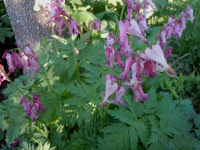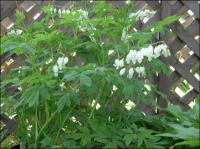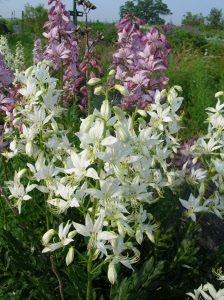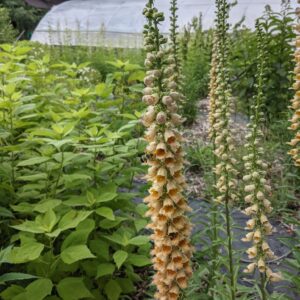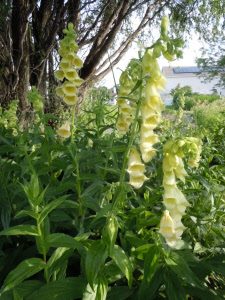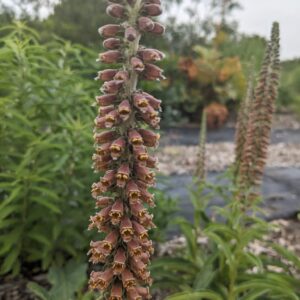Perennials & Biennials
Showing 145–152 of 511 results
-
Dicentra eximia syn Lamprocapnos , Fringed bleeding heart Z 4-8
May to October, dangling rose pink heart-shaped panicles
OUT OF STOCK
May to October dangling rose pink heart-shaped panicles among fern-like, grey-green foliage. They appear delicate but are not.
Size: 8” x 8”
Care: Part shade, moist to moist well-drained soil
Native: Mountains from New York to Georgia
Wildlife Value: Nectar source for hummingbirds & White swallowtail butterfly.Dicentra derived from Greek dis meaning two and kentros meaning spurs. Introduced to gardens by Quaker planthunter and nurseryman John Bartram (1699-1777) in mid-1700’s. Recommended by Gertrude Jekyll, mother of mixed perennial borders, in 1908.
**LISTED AS OUT OF STOCK BECAUSE WE DO NOT SHIP THIS ITEM. IT IS AVAILABLE FOR PURCHASE AT OUR RETAIL LOCATION.
-
Dicentra spectablis Alba syn Lamprocapnos spectabilis White bleeding heart Z 3-9
Dangling alabaster, heart shaped blossoms
May – June Legendary dangling alabaster, heart shaped blossoms. One of the best.
Size: 36" x 18"
Care: Part shade to shade in moist well-drained soil.
Native: JapanDicentra derived from Greek dis meaning “two” and kentros meaning “spurs.” The white form in gardens in the West 1877.
-
Dicentra spectablis syn Lamprocapnos spectabilis Bleeding Heart Z 3-9
May - June legendary dangling dark pink heart shaped blossoms. One of the best.
OUT OF STOCK
From May through June legendary dangling, dark pink heart-shaped blossoms. One of the best.
Size: 36" x 18"
Care: Part shade to shade, moist well-drained soil.
Native: Japan
Awards: Royal Horticultural Society Award of MeritDicentra derived from Greek dis meaning “two” and kentros meaning “spurs” because the flowers have two spurs. Spectabilis means “worthy of notice.” The Bleeding heart was a favorite garden plant in China for centuries before its discovery by Europeans. Introduced to the West in 1846 after Robert Fortune found it growing on the Island of Chusan and sent it to the Horticultural Society of London. It became an immediate sensation in England. By 1866 the Bleeding heart was available in America.
**LISTED AS OUT OF STOCK BECAUSE WE DO NOT SHIP THIS ITEM. IT IS AVAILABLE FOR PURCHASE AT OUR RETAIL LOCATION.
-
Dictamnus fraxinella syn. D. alba Gas plant, Burning bush Z 3-9
Magestic white or pink spikes of flowers in early summer, glossy, lemon-scented leaves
Magestic white or pink spikes of flowers in early summer, glossy, lemon scented leaves.
OUT OF STOCK
Size: 2-3' x 2' slow growing
Care: full sun to part shade in well-drained soil.
Native: Europe
Wildlife Value: Host for Giant Swallowtail caterpillars. Rabbit & deer resistant.
Awards: England’s Royal Horticultural Society Award of Merit.Dictamnus is from the mountain Dicte, located in Crete. Popular Elizabethan cottage garden plant since the late 1500’s. English herbalist John Gerard (1545-1612) called it “gallant.” Grown in the Eichstätt Garden, the garden of Johann Konrad von Gemmingen, prince bishop of Eichstätt in Bavaria, c. 1600. Grown by Jefferson at Monticello in the “center of the NW shrub circle,”1807. The roots used medicinally “resisting purification and poison.” Gardeners’ Dictionary, 1768. Once established very long-lived plant, “known to stand on the same place for fifty years still bearing healthy blooms.” The Garden Feb 19, 1876.
-
Digitalis ferruguina Rusty foxglove Z 4-7
Mottled rusty bells with brown speckled throats & hairy lips clothe the spikes in mid-summer. One of internationally known garden designer Piet Oudolf’s 100 “MUST HAVE” plants, Gardens Illustrated 94 (2013)
Mottled rusty bells with brown speckled throats & hairy lips clothe the spikes in mid-summer. One of internationally known garden designer Piet Oudolf’s 100 “MUST HAVE” plants, Gardens Illustrated 94 (2013)
Size: 4-5' x 18"
Care: sun to part shade in moist well-drained soil.
Native: Southern Europe and Balkans
Awards: England’s Royal Horticultural Society Award of Merit. Elisabeth Carey Miller Botanical Garden Great Plant Pick.The word ‘fox’ is said to be a corruption of ‘folk,’ meaning the ‘little folk’ or fairies. Foxgloves reputedly had the power to ward off witches and return children kidnapped by fairies Ferruginea means rust-colored from ferric describing metal containing iron. This species in garden cultivation since at least the 1590’s.
-
Digitalis grandiflora Yellow foxglove Z 4-8
Early to midsummer spires of moon yellow bells dress the flower spikes. Will rebloom if deadhead.
Early to midsummer spires of moon yellow bells dress the flower spikes. Will rebloom if deadheaded.
Size: 36" x 18"
Care: Sun to part sun, moist well-drained soil.
Native: Europe to Siberia and south to Turkey
Awards: Royal Horticultural Society Award of Merit. Elisabeth Carey Miller Botanical Garden Great Plant Pick.Liberty Hyde Bailey called foxgloves: “old-fashioned and dignified… The word ‘fox’ is often said to be a corruption of ‘folk,’ meaning the ‘little folk’ or fairies.” Foxgloves reputedly had the power to ward off witches and return children kidnapped by fairies. This species grown in the Eichstätt Garden, the garden of Johann Konrad von Gemmingen, prince bishop of Eichstätt in Bavaria, c. 1600. Common in Elizabethan cottage gardens.
-
Digitalis lutea Straw foxglove, Small yellow foxglove Z 3-9
Mid-summer, honey yellow, small bells encircle the flower spike
Mid-summer, honey yellow, small bells encircle the flower spike.
Size: 24" x 12"
Care: Sun to part shade in moist well-drained soil.
Native: Central Europe south to NW AfricaThe word ‘fox’ is often said to be a corruption of ‘folk,’ meaning the ‘little folk’ or fairies.” Foxgloves reputedly had the power to ward off witches and return children kidnapped by fairies. This species identified by Bavarian physician Leonhart Fuchs (1501-1566) in 1542. D. lutea mentioned in Gerard’s Herball in 1632.
-
Digitalis parviflora Chocolate foxglove Z 3-9
Spikes densely encircled with small, red-brown bells for weeks in summer, prune back after flowering to encourage reflowering.
OUT OF STOCK
Spikes densely encircled with small, red-brown bells for weeks in summer, prune back after flowering to encourage reflowering.
Size: 24- 60” x 12”
Care: sun to part shade in moist well-drained to well-drained soil
Native: Picos de Europa Mountains of Northern Spain
Wildlife Value: attracts bees and butterflies for its pollen and nectar, deer and rabbit resistant.
Awards: Royal Horticultural Society Award of Garden MeritGrown by Tradescant the Elder, 1634.

